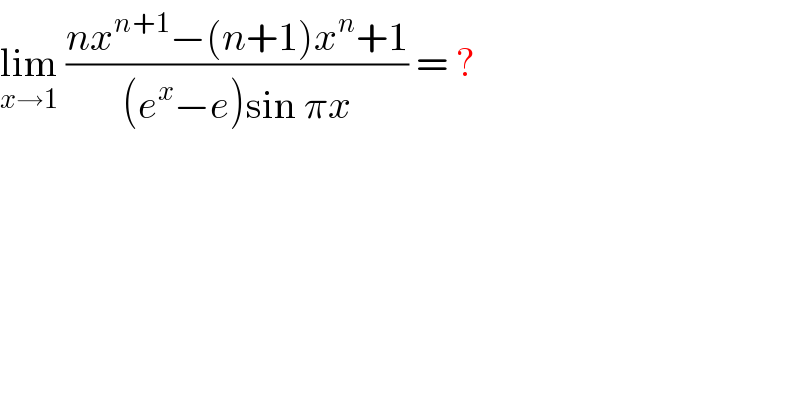
Question and Answers Forum
Question Number 34982 by rahul 19 last updated on 14/May/18

Commented by math khazana by abdo last updated on 15/May/18

Commented by rahul 19 last updated on 16/May/18
Thank You prof. Abdo����
Answered by ajfour last updated on 14/May/18
![=lim_(x→1) ((n(n+1)x^(n−1) (x−1))/(e^x sin πx+π(e^x −e)cos πx)) =lim_(x→1) ((n(n+1)x^(n−1) (x−1))/(e^x sin πx+πe(e^(x−1) −1)cos πx)) = ((n(n+1))/(lim_(x→1) ((e^x sin πx)/(x−1))+lim_(x→1) ((πecos πx(e^(x−1) −1))/(x−1)))) =((n(n+1))/(lim_(x→1) ((e^x sin [π+π(x−1)])/(x−1))−πe)) =((n(n+1))/(−2πe)) = ((−n(n+1))/(2πe)) .](Q34991.png)
Commented by rahul 19 last updated on 14/May/18

Answered by tanmay.chaudhury50@gmail.com last updated on 14/May/18
![=((lim)/(x→1))((nx^(n+1) −nx^n −x^n +1)/(e(e^(x−1) −1)sinΠx)) =((lim)/(x→1)) ((nx^n (x−1−(x^n −1))/(e(e^(x−1) −1)sinΠx)) t=x−1 when x→1 t→0 =((lim)/(x→1))((nx^n (x−1)−(x−1)(x^(n−1) +x^(n−2) +....+1))/(e(e^(x−1) −1)sin(Πx))) =((lim)/(x→1 ))((nx^n −(x^(n−1) +x^(n−2) +...1))/(((e(e^(x−1) −1))/(x−1))×sinΠx)) =((lim)/(x→1))((nx^n −(x^(n−1) +x^(n−2) +...+1))/(sinΠx))× ((lim)/(x→1))(1/((e(e^(x−1) −1))/(x−1)))→its value is (1/e) =(1/e)((lim)/(x→1)) ((nx^n −(x^(n−1) +x^(n−2) +...x^(n−(n−1)) +x^(n−n) ))/(sinΠx)) N_r =(1/e)((lim)/(x→1))((n^2 x^(n−1) −{(n−1)x^(n−2) +(n−2)x^(n−3) +..)/) +∣n−(n−1)^� ∣x^(n−(n−1)−1) +0} D_r =((lim)/(x→1))ΠcosΠx so D_r =−Π using l′hospital N_r =(1/e)[n^2 −{(n−1)+(n−2)+(n−3)+...+1} 1=(n−1)+(k−1)×−1 1=n−1−k+1 k=n−1 N_r =(1/e)[n^2 −((n−1)/2)(n−1+1)} =(1/e)[((2n^2 −n^2 +n)/2)] =((n^2 +n)/(2e)) so value ofgiven limit=((n^2 +n)/(−2Πe)) pls check the answer](Q34997.png)
Commented by rahul 19 last updated on 14/May/18

